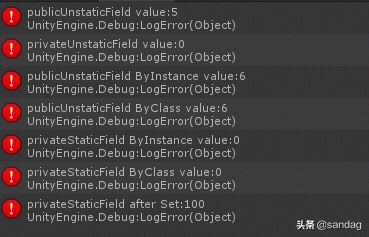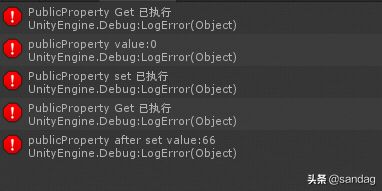前言:反射在日常编程中由于接触较少,所以在大家眼中总是一个神秘的存在,也会觉得反射是一件复杂的事情,今天就在这里帮助大家了解一些反射的基础操作,其实反射很简单!
通过本文你将了解到?
- 什么是反射?
- 如何反射获取属性?
- 如何反射获取访问器?
- 如何反射获取方法?
- 现成的代码(copy直接使用,甚至不需要理解)以及图文解释。
什么是反射?
反射机制是在运行状态中,对于任意一个类,都能够知道这个类的所有属性和方法,对于任意一个对象,都能够调用它的任意一个方法和属性,是一种动态获取的信息以及动态调用对象的方法的功能。
那么在介绍前先创建个反射的目标类,接下来将通过反射方法获取此类所有数据:
namespace TestReflection
{
public class TestReflectionClass
{
private int privateUnStatic;
private static int privateStatic;
public int publicUnStatic;
public static int publicStatic;
public int PublicProperty
{
set
{
privateUnStatic = value;
Debug.LogError("PublicProperty set 已执行");
}
get
{
Debug.LogError("PublicProperty Get 已执行");
return privateUnStatic;
}
}
public void TestFunc()
{
Debug.LogError("this is a function!");
}
public int TestFuncWithParam(int a, int b)
{
int sum = a + b;
return sum;
}
}
}反射获取属性
获取属性主要是通过Type的GetField()方法来获取,下面案例列举所有情况,请细品~
获取属性代码:
public void TestField()
{
TestReflectionClass testCase = new TestReflectionClass()
{
publicUnStatic = 5,
};
TestReflectionClass.publicStatic = 6;
//获得指定类型所在程序集
Assembly testClassAssembly = Assembly.GetAssembly(typeof(TestReflection.TestReflectionClass));
//获取测试类型
Type testClass = testClassAssembly.GetType("TestReflection.TestReflectionClass");
//获取public非static属性
FieldInfo publicUnstaticField = testClass.GetField("publicUnStatic");
Debug.LogError("publicUnstaticField value:" + publicUnstaticField.GetValue(testCase));
//获取private非static属性
FieldInfo privateUnstaticField = testClass.GetField("privateUnStatic",BindingFlags.Instance|BindingFlags.NonPublic);
Debug.LogError("privateUnstaticField value:" + privateUnstaticField.GetValue(testCase));
//获取public static属性
FieldInfo publicStaticField = testClass.GetField("publicStatic");
Debug.LogError("publicUnstaticField ByInstance value:" + publicStaticField.GetValue(testCase));
Debug.LogError("publicUnstaticField ByClass value:" + publicStaticField.GetValue(null));
//获取private static属性
FieldInfo privateStaticField = testClass.GetField("privateStatic",BindingFlags.Static | BindingFlags.NonPublic);
Debug.LogError("privateStaticField ByInstance value:" + privateStaticField.GetValue(testCase));
Debug.LogError("privateStaticField ByClass value:" + privateStaticField.GetValue(null));
privateStaticField.SetValue(null,100);
Debug.LogError("privateStaticField after Set:" + privateStaticField.GetValue(null));
}方法执行后的日志:

反射获取访问器
获取访问器主要是通过Type的GetProperty()方法来获取,由于和属性的获取有许多相似之处,下面案例列了举部分情况,请细品~
获取访问器代码:
public void TestProperty()
{
TestReflectionClass testCase = new TestReflectionClass();
Type testClass = typeof(TestReflectionClass);
//获取public属性
PropertyInfo publicProperty = testClass.GetProperty("PublicProperty");
Debug.LogError("publicProperty value:" + publicProperty.GetValue(testCase));
publicProperty.SetValue(testCase,66);
Debug.LogError("publicProperty after set value:" + publicProperty.GetValue(testCase));
//其他类型属性类似,可参考field,不在介绍
}方法执行后的日志:

反射获取方法
获取方法主要是通过Type的GetMethod()方法来获取,由于和属性的获取有许多相似之处,下面案例列了举部分情况,请细品~
获取方法代码:
public void TestMethod()
{
TestReflectionClass testCase = new TestReflectionClass();
Type testClass = typeof(TestReflectionClass);
//反射调用普通方法
MethodInfo testFunc = testClass.GetMethod("TestFunc");
testFunc.Invoke(testCase, null);
//反射调用带参方法
MethodInfo testFunc1 = testClass.GetMethod("TestFuncWithParam");
int sum =(int)testFunc1.Invoke(testCase,new object[]{6,7});
Debug.LogError("sum:"+sum);
}方法执行后的日志:

结语:方法中有注释,以及最终的结果图都打印出来了,此篇为反射基础,之后会逐步推出更深入的研究,关注,带你飞!